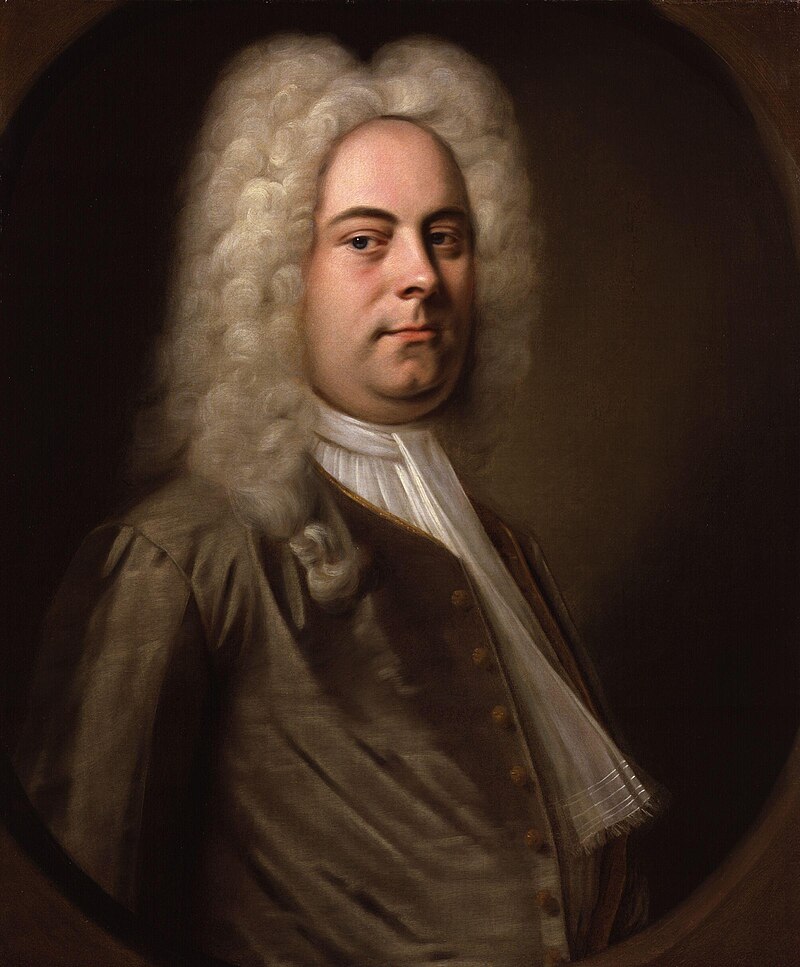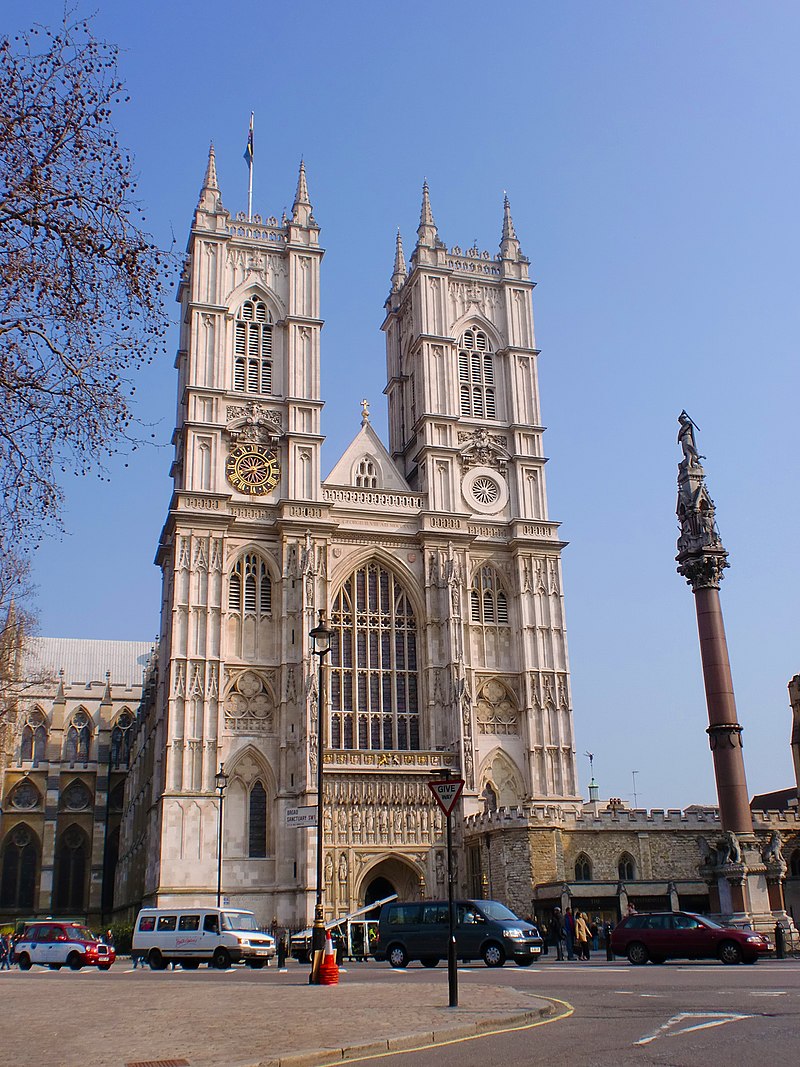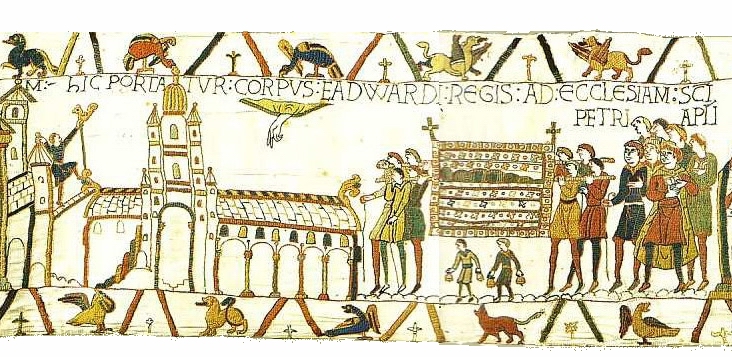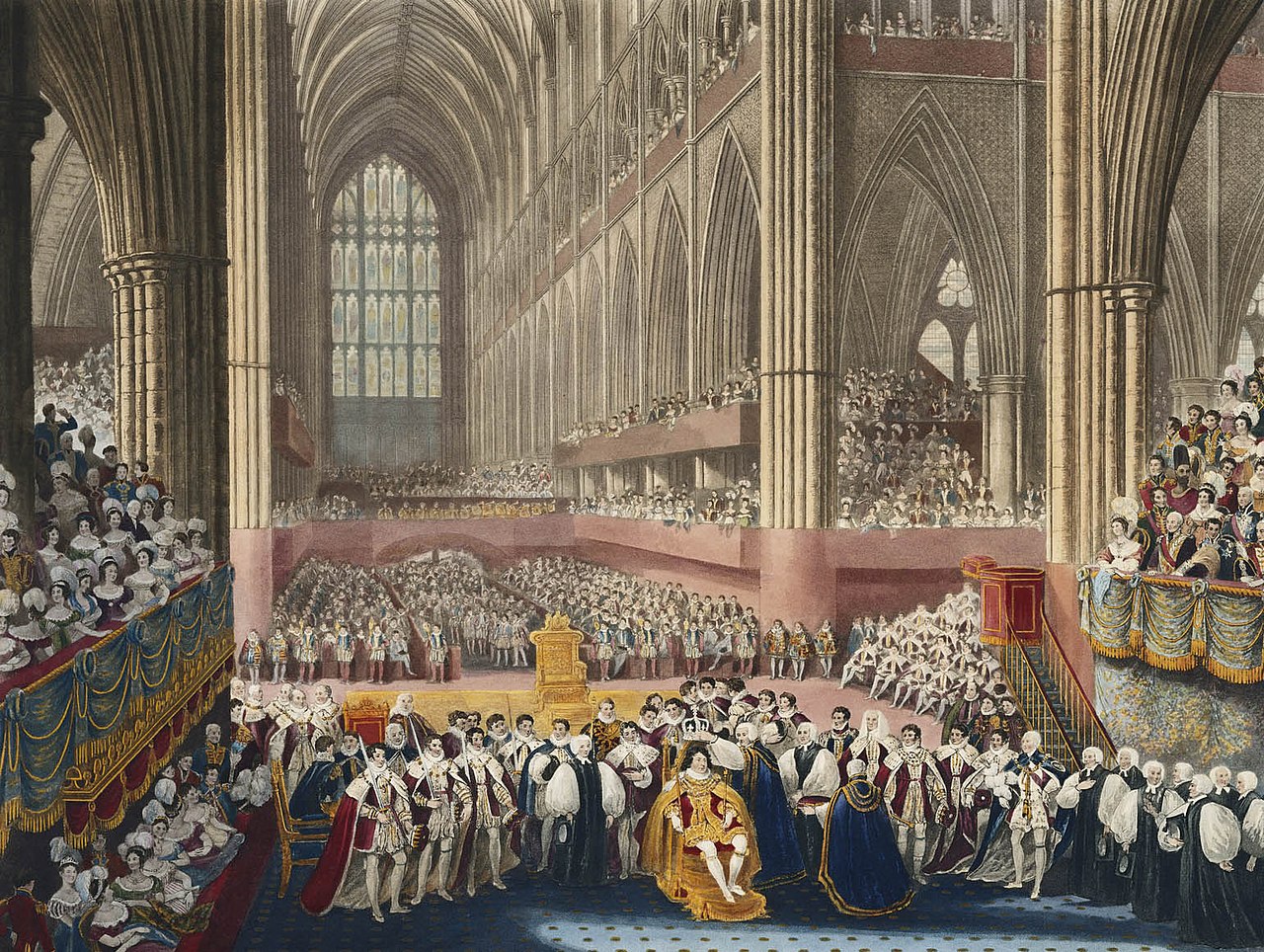by Susan Flantzer
© Unofficial Royalty 2023

St. Dunstan, Archbishop of Canterbury crowns Edgar the Peaceful, King of the English Stained glass at Bath Abbey; Credit – By Jules & Jenny from Lincoln, UK https://commons.wikimedia.org/w/index.php?curid=71397822
The coronation of the British monarch has its roots in the Kings of Wessex and the early Anglo-Saxon Kings of the English being installed on the Kings’ Stone or Coronation Stone which can still be seen in Kingston-upon-Thames, Surrey, England.

Coronation Stone in Kingston-upon-Thames, England; Credit – By Hellodavey1902 Own work, CC BY-SA 4.0, https://commons.wikimedia.org/w/index.php?curid=94084918
For the coronation of Edgar the Peaceful, King of the English in 973, Saint Dunstan, Archbishop of Canterbury felt there was a need for a major ceremony similar to the coronations of the King of the Franks and the German Emperor. Although Edgar probably had a ceremony at Kingston-on-Thames, a coronation using Dunstan’s order of service was held for Edgar at Bath Abbey in Bath, England on May 11, 973. Since then, the main elements of the British coronation service and the form of the oath taken by the sovereign can be traced to the order of service devised by Saint Dunstan, Archbishop of Canterbury.
Although the coronation service, which takes place within the service for Holy Communion, has had translations, revisions, and modifications over the centuries, the sequence of taking an oath, anointing, investing of regalia, crowning, and enthronement found in the Anglo-Saxon original text has remained constant. The coronation involves six basic stages based on the coronation service written by Saint Dunstan, Archbishop of Canterbury used in 973 for King Edgar: The recognition, the oath, the anointing, the investiture/the crowning, the enthronement, and the homage.
What follows below is the basic order of service based upon past coronations. For more information, see the complete Orders of Service and the Unofficial Royaly articles for the last two coronations, linked below. In addition, after the sections dealing with the stages of the Coronation, there are short YouTube videos showing that stage from Queen Elizabeth II’s Coronation.
The Order of Service released by the Church of England on April 29, 2023, for coronation of King Charles III and Queen Camilla follows the six basic stages listed above but the text of the service is quite different from the text of past coronations. There have also been some changes in the Order of Service for King Charles III and Queen Consort Camilla’s coronation. For instance, Prince William, The Prince of Wales will be the only Prince of Blood Royal to do the Homage. You can see the order of service for the coronation of King Charles III and Queen Camilla at the following link:
Coronation of a King and Queen Consort
- Unofficial Royalty: Coronation of King George VI and Queen Elizabeth (1937)
- Oremus: The Form and Order of Service of the Coronation of Their Majesties King George VI and Queen Elizabeth
Coronation of a Monarch
- Unofficial Royalty: Coronation of Queen Elizabeth II (1953)
- Oremus: Form and Order of the Service of the Coronation of Her Majesty Queen Elizabeth II
*********************
The Recognition
The Recognition of King George VI, 1937
The Recognition involves the presentation of the monarch to the people and dates back to ancient practices of the Witan, the king’s council of England during the Anglo-Saxon period. The Garter Principal King of Arms, the Archbishop of Canterbury, the Lord Chancellor, the Lord Great Chamberlain, the Lord High Constable, and the Earl Marshal all go to the east, south, west, and north of the coronation theatre. On each side of the coronation theatre, the Archbishop of Canterbury calls for the recognition of the monarch, with the words:
“Sirs, I here present unto you [name], your undoubted King/Queen. Wherefore all you who are come this day to do your homage and service, are you willing to do the same?” The People reply each time, “God Save King/Queen [name].”
The Oath
King Edward VII swearing the Oath, 1902
The monarch sits in the Chair of Estate. The Chairs of Estate for the monarch and queen consort, if there is one, are placed on the south side of the coronation theatre. These chairs are used during the first part of the service, before the monarch’s anointing and crowning. In the Oath, the monarch makes a series of promises: to reign according to the law, to exercise justice with mercy, and to maintain the Church of England. The Oath is administered by the Archbishop of Canterbury. The monarch proceeds to the altar and solemnly swears the Oath with his/her right hand on the Bible. Afterward, he/she kisses the Bible and signs the Oath.
Below is the Oath King Edgar took in 973, followed by the Oath Queen Elizabeth II took in 1953. Although Queen Elizabeth II’s Oath is longer, similar themes are obvious.
King Edgar’s 973 Oath
In the name of the Holy Trinity, I promise three things to the Christian people subject to me:
- Firstly, that God’s church and all the Christian people of my dominions will be held in true peace
- Secondly, I forbid robbery and all unlawful deeds by all ranks of men.
- Thirdly, I promise and command justice and mercy in all judgments, in order that the gracious and merciful lord, who liveth and reigneth, may thereby forgive us all through his everlasting mercy.
Queen Elizabeth II’s 1953 Oath
The Archbishop of Canterbury asked The Queen these questions to which she responded, “I will.”
- Will you solemnly promise and swear to govern the Peoples of the United Kingdom of Great Britain and Northern Ireland, Canada, Australia, New Zealand, the Union of South Africa, Pakistan and Ceylon, and of your Possessions and other Territories to any of them belonging or pertaining, according to their respective laws and customs?
- Will you to your power cause Law and Justice, in Mercy, to be executed in all your judgments?
- Will you to the utmost of your power maintain the Laws of God and the true profession of the Gospel?
- Will you to the utmost of your power maintain in the United Kingdom the Protestant Reformed Religion established by law?
- Will you maintain and preserve inviolably the settlement of the Church of England, and the doctrine, worship, discipline, and government thereof, as by law established in England?
- And will you preserve unto the Bishops and Clergy of England, and to the Churches there committed to their charge, all such rights and privileges, as by law do or shall appertain to them or any of them?
The Anointing
The canopy is placed over Queen Elizabeth II for the anointing, 1953
During the most sacred part of the coronation, the monarch is anointed, blessed, and consecrated by the Archbishop of Canterbury. The choir sings Veni, Creator Spiritus (Come, Holy Spirit).
After some prayers, the choir sings one of the Coronation Anthems by George Frideric Handel, the rousing Zadok the Priest. Written for and first performed at the coronation of King George II, it has been sung at every coronation ever since. The words, taken from the Old Testament, are: “Zadok the priest and Nathan the prophet anointed Solomon king; and all the people rejoiced and said: God save the king, Long live the king, May the king live forever. Amen. Hallelujah.”
During the singing of Zadok the Priest, the monarch is disrobed of his/her crimson robe, and as the anthem ends, the monarch is seated on the Coronation Chair, also called St. Edward’s Chair and King Edward’s Chair.
You can see a concert performance of Zadok the Priest with orchestra and choir at the link below.
Four Knights of the Garter hold a canopy over the monarch for privacy. There is no video or photographs of the anointing. The Dean of Westminster pours Holy Oil from the Ampulla into the Spoon. The Archbishop of Canterbury then anoints the monarch in the form of a cross on the palms of both hands, the breast, and the crown of the head.
The Investiture and The Crowning
The Crowning of Queen Elizabeth II, 1953
After being sanctified with Holy Oil and the Archbishop of Canterbury’s blessing, the monarch is dressed in the Colobium Sindonis, a sleeveless white garment, and the Supertunica, a robe of cloth of gold a long coat of gold that reaches to the ankles and has wide-flowing sleeves. While the monarch is sitting in the Coronation Chair, the Lord Great Chamberlain presents the Golden Spurs, a symbol of chivalry, and the Archbishop of Canterbury, assisted by the Archbishop of York, the Bishop of London, and the Bishop of Winchester, presents the monarch with the Sword of Offering. The monarch then goes to the altar, returns the sword to its scabbard, and sits down in the Coronation Chair.
The Dean of Westminster gives the Armills to the Archbishop of Canterbury, who says a prayer while putting the Armills on the monarch’s wrists. The monarch stands and the Robe Royal and Stole Royal are placed on top of the Supertunica. After the monarch sits back down in the Coronation Chair, the Sovereign’s Orb is brought from the altar by the Dean of Westminster and is delivered into the monarch’s right hand by the Archbishop of Canterbury. The monarch then gives the Orb to the Dean of Westminster who returns it to the altar.
The Archbishop of Canterbury places the Coronation Ring on the fourth finger of the monarch’s right hand. The Dean of Westminster brings the Sceptre with the Cross and the Sceptre with the Dove to the Archbishop of Canterbury, who puts it in the monarch’s hands.
The video below is titled The Holy Anointing but as noted above, there was no video or photographs of the anointing so little is seen. The video does show Queen Elizabeth II being clothed with Colobium Sindonis and the Supertunica, and receiving the Sword of Offering.
The congregation stands up and the Archbishop of Canterbury takes St. Edward’s Crown from the altar, then lays it back on the altar, and says a prayer. The Archbishop of Canterbury proceeds to the monarch who is sitting in the Coronation Chair. The Dean of Westminster brings the St. Edward’s Crown to the Archbishop of Canterbury who reverently puts the crown on the monarch’s head. The congregation repeatedly shouts, “God Save The King/Queen.” The princes and princesses, the peers and peeresses put on their coronets and caps. Trumpets sound and the great guns at the Tower of London are fired.
The Enthronement
After a blessing, the monarch goes to the throne and is lifted up into it by the archbishops and bishops, and other peers of the kingdom. The monarch will receive the Homage while seated in the throne.
The Homage
The Homage at the Coronation of King Edward VII, 1902
The Archbishop of Canterbury kneels down before the monarch while the rest of the Bishops kneel in their places and do their Homage together. As the Archbishop of Canterbury says the following, each Bishop also says it: “I <name>, Archbishop of Canterbury [Bishops say, I <name> Bishop of <place>] will be faithful and true, and faith and truth will bear unto you, our Sovereign Lord/ Lady, King/Queen of this Realm and Defender of the Faith, and unto your heirs and successors according to law. So help me God.”
The Royal Dukes and Princes of the Blood take off their coronets, kneel down before the monarch (this has been done individually or in a group with the senior Royal Duke of Prince of the Blood kneeling directly before the monarch), and pronounce the words of the Homage, “I <name> Prince, or Duke of <place> do become your Liege man of Life and Limb, and of earthly worship; and Faith and Truth I will bear unto you, to live and die, against all manner of Folks. So help me God.”
The most senior peer of each of the five ranks of peerage – Duke, Marquess, Earl, Viscount, and Baron – individually kneels before the monarch. The other peers who are in seats, in turn, kneel down, take off their coronets, and do their homage: the Dukes first by themselves, then the Marquesses, the Earls, the Viscounts, and the Barons. Each rank of the peerage, saying together, “I, <name> Duke, or Marquess, Earl, Viscount, Baron of <place> do become your liege man of Life and Limb, and of earthly worship; and Faith and Truth I will bear unto you, to live and die, against all manner of Folks. So help me God.
The Queen Consort’s Coronation
The Archbishop of Canterbury crowns Queen Elizabeth, the Queen Consort of King George VI, 1937
If there is a Queen Consort, her anointing and crowning happen after the Homage.
The queen consort goes to the steps of the altar, and supported by two bishops, kneels down on the faldstool (kneeler) placed before the High Altar. The Archbishop of Canterbury says a prayer asking God’s blessing upon the queen consort. Four peeresses hold a canopy over her for privacy. The Archbishop of Canterbury anoints the crown of the queen consort’s head and placed the Queen Consort’s Ring on her fourth finger on her right hand. The Archbishop of Canterbury then takes the Queen’s Crown – Queen Consort Camilla used Queen Mary’s Crown – from the high altar and reverently sets it upon the queen’s head, at which time, the princesses and peeresses put their coronets on their heads. The queen consort is then handed her Sceptre with the Cross and the Ivory Rod with the Dove, and walks over to her own throne beside the King, where she sits.
The Communion

Queen Victoria receiving Holy Communion at her Coronation, 1838 by Charles Robert Leslie
The monarch (and queen consort) kneels and takes Holy Communion during a service that includes a general confession and absolution, and, along with the people, the reciting of the Lord’s Prayer.
The Recess
Queen Elizabeth II wearing the Imperial State Crown and carrying the Orb and Sceptre with Cross leaves Westminster Abbey at the end of the Coronation Ceremony
The monarch (and queen consort) proceeds to St. Edward’s Chapel, directly behind the High Altar, and gives St. Edward’s Crown, the Sceptre, and the Rod to the Archbishop of Canterbury who lays them on the altar in the chapel. The monarch is disrobed of the Robe Royal and clothed in a Robe of purple velvet and the Imperial State Crown. The Archbishop of Canterbury puts the Sceptre with the Cross into his/her right hand and the Orb in his/her left hand. The monarch (and the queen consort still carrying her Sceptre with the Cross in her right hand and the Ivory Rod with the Dove in her left hand) leaves St. Edward’s Chapel to the singing of the National Anthem and then proceeds up the aisle.
This article is the intellectual property of Unofficial Royalty and is NOT TO BE COPIED, EDITED, OR POSTED IN ANY FORM ON ANOTHER WEBSITE under any circumstances. It is permissible to use a link that directs to Unofficial Royalty.
Works Cited
- A Guide to Coronations (no date) Westminster Abbey. Available at: https://www.westminster-abbey.org/about-the-abbey/history/coronations-at-the-abbey/a-guide-to-coronations (Accessed: March 31, 2023).
- A History of Coronations (no date) Westminster Abbey. Available at: https://www.westminster-abbey.org/about-the-abbey/history/coronations-at-the-abbey/a-history-of-coronations (Accessed: March 31, 2023).
- Flantzer, Susan. (2023) Coronation of King George VI and Queen Elizabeth, Unofficial Royalty. Available at: https://www.unofficialroyalty.com/coronation-of-king-george-vi-and-queen-elizabeth/ (Accessed: March 31, 2023).
- Flantzer, Susan. (2017) Coronation of Queen Elizabeth II, Unofficial Royalty. Available at: https://www.unofficialroyalty.com/june-2-1953-coronation-of-queen-elizabeth-ii-at-westminster-abbey/ (Accessed: March 31, 2023).
- Keay, Anna. (2012) The Crown Jewels. London: Thames and Hudson, Historic Royal Palace.
- Order of Service (no date) Westminster Abbey. Available at: https://www.westminster-abbey.org/about-the-abbey/history/coronations-at-the-abbey/spotlight-on-coronations/order-of-service (Accessed: March 31, 2023).
- Strong, Roy. (2005, 2022) Coronation – A History of the British Monarchy. London: William Collins.
- The Coronation of King George VI and Queen Elizabeth in 1937 (no date) Oremus. Available at: https://www.oremus.org/coronation/1937/ (Accessed: March 31, 2023).
- The Form and Order of Service that is to be performed and the Ceremonies that are to be observed in the Coronation of Her Majesty Queen Elizabeth II (no date). Available at: http://www.oremus.org/liturgy/coronation/cor1953b.html (Accessed: March 31, 2023).






















































